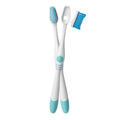Maintaining good oral hygiene is essential for a healthy smile and overall well-being. One of the fundamental aspects of oral care is proper toothbrushing technique. While it may seem simple, there are nuances to brushing that can significantly impact the health of your teeth and gums. In this guide, we'll delve into the tips and techniques for achieving optimal toothbrushing results.
1. Choose the Right Toothbrush
Before diving into technique, it's crucial to start with the right tool. Selecting a toothbrush with soft bristles and a size that comfortably fits your mouth is key. Whether you prefer a manual or electric toothbrush, ensure it has the American Dental Association (ADA) seal of approval, indicating it meets quality and safety standards.
2. Timing is Everything
Brushing your teeth twice a day, ideally in the morning and before bed, is recommended by dental professionals. Aim for at least two minutes each session to thoroughly clean all surfaces of your teeth. Using a timer or brushing to a favorite song can help ensure you're brushing for the recommended duration.
3. Proper Technique
Now, let's focus on the actual brushing technique:
-
Positioning: Hold your toothbrush at a 45-degree angle to your gums. This allows the bristles to clean along the gumline and the surface of the teeth effectively.
-
Gentle Pressure: Avoid aggressive brushing, as it can damage tooth enamel and irritate gums. Instead, apply gentle pressure and let the bristles do the work.
-
Circular Motion: Use small, circular motions to clean each tooth thoroughly. Pay close attention to the front, back, and chewing surfaces of your teeth.
-
Don't Forget the Gumline: Plaque and bacteria often accumulate along the gumline, leading to gum disease if not removed. Brushing gently along the gumline helps prevent tartar buildup and keeps your gums healthy.
-
Tongue and Roof of Mouth: Don't neglect your tongue and the roof of your mouth. Bacteria can accumulate in these areas, contributing to bad breath and oral health issues. Use your toothbrush or a tongue scraper to clean them gently.
4. Rinse and Clean Your Toothbrush
After brushing, thoroughly rinse your toothbrush under running water to remove any remaining toothpaste and debris. Store it in an upright position to allow it to air dry between uses. Additionally, replace your toothbrush or toothbrush head every three to four months, or sooner if the bristles show signs of wear.
5. Don't Skip Flossing and Mouthwash
While proper toothbrushing is essential, it's only part of a comprehensive oral hygiene routine. Don't forget to floss daily to remove plaque and food particles from between your teeth, and use an ADA-approved mouthwash to kill bacteria and freshen your breath.
By incorporating these tips and techniques into your daily oral care routine, you can maintain a healthy, radiant smile for years to come. Remember, consistency is key, so make toothbrushing a priority to reap the benefits of optimal oral health.


